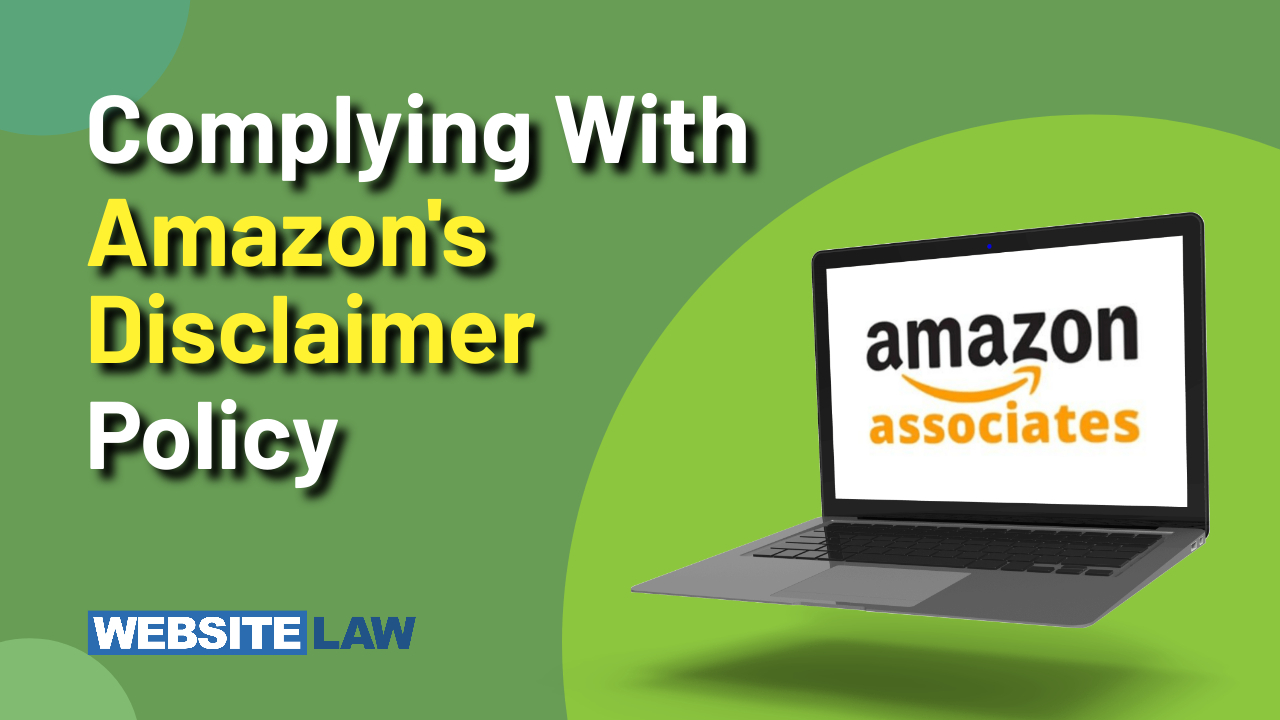Complying with Amazon Associates’ Disclaimer Policy: A Comprehensive Guide for Affiliates
Table of Contents
If you’re an aspiring affiliate marketer looking to monetize your website or blog, Amazon Associates is one of the best programs to consider. With millions of products and a trusted reputation, Amazon offers a lucrative opportunity to earn commissions by promoting their products.
Complying with the Amazon Associates Disclaimer Policy is essential for anyone participating in the Amazon Associates affiliate program. As an affiliate, it is crucial to disclose your relationship with Amazon and the fact that you may earn commissions through any purchases made via your affiliate links.
Amazon requires affiliates to include a disclaimer on their websites, blog posts, or any other platform where affiliate links are used. This disclaimer should be clear and visible to readers, informing them of your participation in the Amazon Associates program. Failure to comply with this policy may result in penalties or even termination from the program. It is important to read and understand Amazon’s guidelines regarding the disclaimer policy to ensure a seamless and compliant affiliate experience. By complying with this policy, affiliates can build trust with their audience while maintaining a positive relationship with Amazon Associates.
Importance of Disclosing Affiliate Relationship
Affiliate disclaimers play a vital role in establishing transparency and trust with website visitors. By clearly stating that you are an Amazon Associate and earn commission from purchases made through your website, you demonstrate honesty and integrity. This disclosure informs your audience that your recommendations may be influenced by financial incentives, allowing them to make informed decisions. Failing to disclose this affiliation can lead to a loss of credibility and trust, which can have detrimental effects on your affiliate marketing efforts.
What To Include In Amazon Affiliate Disclaimer
An affiliate disclaimer should accurately convey your participation in the Amazon Associate Program and the financial relationship you have with Amazon. While the disclaimer can be customized to fit your website’s tone and style, it is essential to include key elements to ensure compliance. These elements include explicitly stating your affiliation with Amazon, clarifying that you earn a commission from qualifying purchases, and emphasizing the benefits of supporting your website through affiliate links.
What are the requirements for the Amazon Associates Program?
Understanding Amazon's Specific Guidelines
Amazon has specific requirements for disclaimers that need to be adhered to by affiliates. According to Amazon’s guidelines, it is necessary to clearly identify your affiliate status on your website. This can be done by including a statement such as “As an Amazon Associate, I earn from qualifying purchases” in a prominent and easily visible location. Furthermore, this disclosure should be present on every page that contains affiliate links, ensuring that
How to disclose your affiliation with Amazon in a transparent manner
Amazon’s Guidelines for Affiliate Disclosures: Amazon has specific guidelines in place to ensure proper disclosure. According to their policy, the disclosure should be clear, conspicuous, and placed before any affiliate links. Here are some key points to keep in mind:
Disclose Early: Place the disclosure at the beginning of your content or within the first few paragraphs to ensure it is seen by your readers.
Use Clear Language: Clearly state that you may receive a commission for purchases made through your links. Avoid vague or confusing language that may mislead your audience.
Visible Placement: Make sure the disclosure is easily noticeable and distinct from the rest of the content. It should not be hidden or buried within your website.
What are the important considerations for the placement of the affiliate disclosure?
Finding the right placement for your Amazon affiliate disclosure depends on the type of content you create and the platform you use. Here are a few effective placement options to consider:
At the Top of Your Content: Placing the disclosure at the beginning of your content ensures it is visible and prominent. It immediately sets the tone and informs your readers about your affiliate relationship.
Within the Introduction: If placing the disclosure at the top feels too abrupt, consider incorporating it within the introduction. This allows you to provide context while being transparent about your affiliation.
Sidebar or Footer: Another option is to include the disclosure in the sidebar or footer of your website. This ensures that it is present on all pages and posts, even if readers do not scroll through the entire content.
Near Affiliate Links: To reinforce transparency, you can also place the disclosure close to each affiliate link. This serves as a reminder to your audience that you may earn a commission from their purchases.
What are the potential consequences of not disclosing affiliate links?
Non-compliance with Amazon’s disclaimer policy can have severe consequences for affiliates. Amazon has a diligent monitoring system in place to ensure that affiliates adhere to their guidelines. If found to be non-compliant, affiliates may face suspension from the program, financial penalties, and even legal action. These consequences not only impact an affiliate’s revenue but also their reputation and ability to continue working with Amazon.
Ensuring Compliance and Avoiding Pitfalls
What are some common mistakes to avoid when creating an affiliate disclosure?
When creating an affiliate disclosure, there are several common mistakes that should be avoided. One major mistake is failing to clearly disclose the affiliate relationship. It is essential to explicitly state that there is an affiliate relationship between the content creator and the products or services being promoted. Another mistake is burying the disclosure in small print or at the bottom of the page. The disclosure should be prominently displayed and easily noticeable for users. Additionally, using vague or confusing language in the disclosure can lead to misunderstandings and potentially violate legal requirements. It is crucial to use simple and straightforward language that is easily understood by your audience. Lastly, not updating or reviewing the disclosure regularly is also a common mistake. As affiliate partnerships may change or new ones may be established, it is important to regularly review and update the disclosure to ensure accuracy and compliance with current regulations. By avoiding these common mistakes, content creators can build trust with their audience and maintain transparency in their affiliate relationships.
How frequently should you update your affiliate disclosure?
How frequently you should update your affiliate disclosure depends on various factors, including changes in the law, updates to your website or content, and any new affiliate relationships. As a general rule, it is recommended to review and update your disclosure at least once a year or whenever there are significant changes to your affiliate marketing practices. This ensures that your readers are always informed about your affiliations and helps to maintain transparency and trust. Additionally, it is essential to update your disclosure if there are any changes in the regulations or guidelines set by the governing bodies or platforms you are affiliated with. By keeping your disclosure up to date, you not only comply with legal requirements but also provide your audience with accurate and relevant information about your affiliate relationships. Regularly reviewing and updating your disclosure demonstrates your commitment to transparency and ethical affiliate marketing practices.
What to do if you are using multiple affiliate programs in addition to Amazon Associates?
When utilizing multiple affiliate programs alongside Amazon Associates, maintaining compliance with disclosure guidelines is paramount. Be sure to create a disclosure statement that encompasses all your partnerships. Clearly state that you are an affiliate marketer and may receive compensation from various products and brands mentioned on your platform. By placing your disclosures prominently and being transparent about your financial relationships, you can foster trust with your audience and ensure the longevity of your affiliate marketing endeavors.
What are the guidelines for using the Amazon logo or trademarks in a disclosure?
When using the Amazon logo or trademarks in a disclosure, there are several guidelines that should be followed to ensure compliance. Firstly, it is important to use the official Amazon logos and not create your own versions. The logo should not be altered in any way, including changing the color or adding any additional elements. It is also crucial to use the logo in its entirety and not crop or obscure any parts of it. When using the Amazon logo, it should be the most prominent element on the page or document where it is displayed. Additionally, it is important to include a statement clarifying that the logo is a trademark of Amazon and that it is used with permission. Lastly, it is advisable to avoid using the logo as a hyperlink or including it alongside any other logos that may create confusion or dilute the impact of the Amazon brand. By adhering to these guidelines, users can ensure that their use of the Amazon logo or trademarks is compliant and respects the integrity of the brand.
Conclusion
Complying with Amazon Associates’ Disclaimer Policy is crucial for maintaining credibility, trust, and a positive affiliate relationship with the platform. By understanding the importance of disclosing the affiliate relationship, following Amazon’s specific guidelines, and crafting an effective affiliate disclaimer, affiliates can ensure compliance and foster transparency with their audience. By doing so, affiliates can build a long-lasting and successful partnership with Amazon while providing valuable recommendations to their website visitors. Remember, transparency and trust are the pillars of a thriving affiliate marketing business.
Marc Rossen
Attorney at Law
Marc Rossen is an attorney who’s practice includes helping web-based businesses navigate the ever-changing legal requirements for websites.


